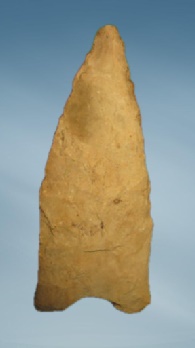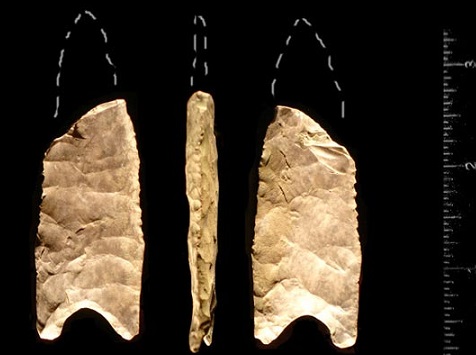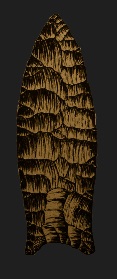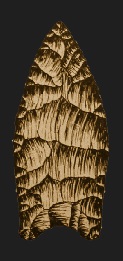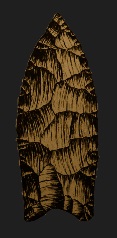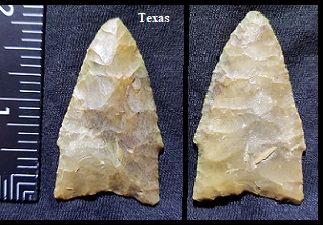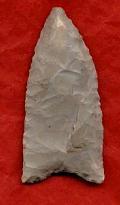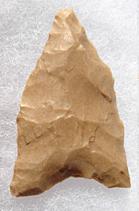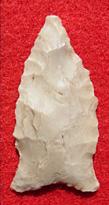Outline is Representative of Size and Shape:

Name Details:
Identified By: LeRoy Johnson Jr.
Named For: Spanish work for Swallow Split Tail bird which the base resembles
Date Identified: 1964
Type Site: The Devils Mouth Site, Amistad Reservoir, Val Verde County, Texas
Identified By: LeRoy Johnson Jr.
Named For: Spanish work for Swallow Split Tail bird which the base resembles
Date Identified: 1964
Type Site: The Devils Mouth Site, Amistad Reservoir, Val Verde County, Texas
Point Validity:
Valid type
Johnson was a distinguished anthropologist who got his start in Texas before moving to become a professor at the University of Ohio and the University of Oregon. He named this type in a professional publication and this type has many professional references. This is considered a valid type.
Johnson was a distinguished anthropologist who got his start in Texas before moving to become a professor at the University of Ohio and the University of Oregon. He named this type in a professional publication and this type has many professional references. This is considered a valid type.
Golondrina Lanceolate
AKA: Plainview GolondrinaCluster: Plano Lanceolate Cluster
Description of Physical Characteristics and Flaking Pattern:
This is
a small (1.25 to 1.75 inch) triangular stemmed to expanding stem point with a flattened cross section. The blade is primarily straight with a sharp tip. The stem is long and
slightly expanding. The base may range from straight to slightly
convex. This point has a random flaking pattern.
Size Measurements:
Length - 32 to 78 mm, Blade Width - 23 to 32mm, Waist Width - typically 1 to 3 mm narrower than blade, Basal Width - 20 to 33 mm, Thickness - 6 to 8mm, Basal Width - 22 to 29mm, Basal Concavity - 4 + mm
Length - 32 to 78 mm, Blade Width - 23 to 32mm, Waist Width - typically 1 to 3 mm narrower than blade, Basal Width - 20 to 33 mm, Thickness - 6 to 8mm, Basal Width - 22 to 29mm, Basal Concavity - 4 + mm
Additional Comments:
This point was originally called the Plainview Golondrina point by LeRoy Johnson. Further studies by T.C. Kelley (1982) determined that this was a distinct type separate from the Plainview point so the name was shortened to Golondrina.
This point is generally wider and thicker than the Plainview type (Turner and Hester, 1985).
This point was originally called the Plainview Golondrina point by LeRoy Johnson. Further studies by T.C. Kelley (1982) determined that this was a distinct type separate from the Plainview point so the name was shortened to Golondrina.
This point is generally wider and thicker than the Plainview type (Turner and Hester, 1985).
Distribution: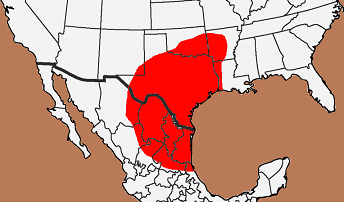

Distribution Comments:
This point is most commonly found in the southern Texas Plains and into southern Tamaulipas, northern Zacatecas and eastern Chihuahua. These points are found throughout Texas and into southeastern New Mexico and into Arkansas. This points have rarely been reported into Missouri, Kansas, and Louisiana.
Age / Periods:
Date: 9,000 - 7,000 B.P.
Cultural Period: Transitional Paleo
Glacial Period: Early to Middle Holocene
Culture:
Date: 9,000 - 7,000 B.P.
Cultural Period: Transitional Paleo
Glacial Period: Early to Middle Holocene
Culture:
Age Details:
At Devils Mouth site, levels containing Golondrina points were radiocarbon dated at 8,700 B.P. At Bakers Cave the stratum containing Golondrina points , remains of small game and various plant remains was termed Golondrina Complex which is attributed to the post Pleistocene period.
At Devils Mouth site, levels containing Golondrina points were radiocarbon dated at 8,700 B.P. At Bakers Cave the stratum containing Golondrina points , remains of small game and various plant remains was termed Golondrina Complex which is attributed to the post Pleistocene period.
Other points in this cluster / Related / Associated Points:
Agate Basin, Angostura, Browns Valley, El Riego, Hell Gap, Midland, Milnesand, Plainview
Agate Basin, Angostura, Browns Valley, El Riego, Hell Gap, Midland, Milnesand, Plainview

